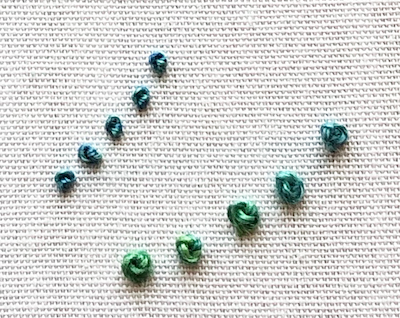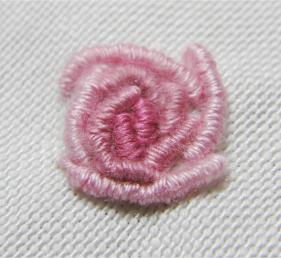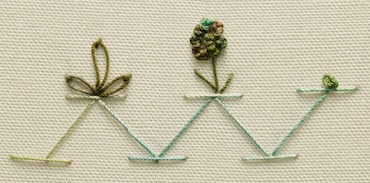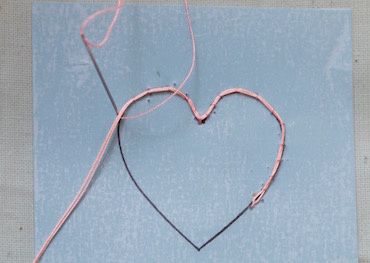- Home
- Different Types of Embroidery Stitches
A bonanza of different types of embroidery stitches for all abilities
We can categorize different types of embroidery stitches by the techniques used to create them.
Many hand sewing stitches are combined to form something unique. When you include the multitude of different threads into the mix, there are just too many variations to classify them all. Understanding the basics and variations of common embroidery techniques will help you choose those best suited to your designs.

Distinguishing Stitches From Each Other
Embroidery stitches have interesting names that may describe how they are formed or an object they are said to resemble, such as herringbone or chain stitch.
Their names may differ depending on where they come from. For example, the French name, broderie anglaise, is often preferred over the translation "English embroidery".
It can be confusing to beginners when they encounter stitches with a name that is not familiar. However, knowing the correct name of an embroidery stitch will help you identify it in reference books and identification charts.
Some stitches have similar names but are constructed in a different manner further confusing the issue.
Different kinds of stitches
All embroidery stitches break down into four basic stitch structures: flat, crossed, looped or knotted.
Each stitch type can be used to either outline or fill an area. Knowing which stitch to choose comes with some experience. Usually, beginners will use a combination of basic embroidery stitches that are largely dependent upon the type of fabric and design selected.
Once you have mastered the basic stitches, you can start experimenting with more complex ones. With practice, you will become more confident in selecting the right stitch for each project and creating beautiful works of art with your needle and thread
Let's look at each type in turn.
Flat stitches
 This tulip project shows stem stitch, split stitch and french knots.
This tulip project shows stem stitch, split stitch and french knots.Flat stitch refers to stitches that can be stitched in different lengths and directions. Often used for outlining a design, they can also be worked to fill an area. Depending on the thread used, the stitches can catch the light meaning any changes in direction within a filled area will be obvious. You can make a feature of this, or be extra careful to avoid it, as a personal choice.
This group includes simple and double running stitch, back, stem, split, satin, chevron and long and short stitch.
 This simple flower was worked in long and short stitch (also known as needlepainting)
This simple flower was worked in long and short stitch (also known as needlepainting)Crossed stitches
Crossed stitches are formed by two or more straight stitches that cross each other, forming a grid-like pattern. They can be worked to the counted thread or free hand.
Cross stitches are often used to fill in large areas by following a chart where each symbol represents a thread colour.
Long-armed cross stitch is commonly used when doing assisi work where the stitching surrounds a voided area.
This group also includes herringbone stitch, sometimes known as Russian cross stitch, fishbone and leaf stitch.
 Herringbone stitch being worked shows how the stitches cross over each other
Herringbone stitch being worked shows how the stitches cross over each otherLooped stitches
This type of stitch is created by laying a loop of the working thread on the fabric surface and then holding that down with a stitch. This describes the traditional chain stitch, however there are many variations on the basic stitch, some of which are used in my free little fishy project, while the detached version, commonly called lazy daisy, features in my strawberry motif.
 Chain stitch variations used to depict a fish
Chain stitch variations used to depict a fishFeather stitch, blanket and buttonhole stitch are formed in a similar manner. Another looped option is the wheat-ear stitch which makes an attractive filling when worked individually.
Cretan and fly stitch are also members of this group as is vandyke.
 Feather stitch used to depict coral
Feather stitch used to depict coralKnotted stitches
This stitch type is formed by twisting or knotting the thread around itself or the fabric's surface. This creates a textured look that can be highly desirable in the finished piece.
Knots can be worked individually, in rows or scattered within an area.
 Colonial and French knots
Colonial and French knotsThis group includes French and Colonial knots, Bullions, coral knot, scroll stitch, and double knot or palestrina.
A number of other basic stitches also have knotted versions, such as Portuguese knotted stem stitch, knotted chain, knotted buttonhole and some forms of laid work.
 A rose made with bullion knots
A rose made with bullion knotsDeveloping stitches further
The basic stitches in the above four groups have developed over time for specific uses within the field of embroidery. They can also be used in conjunction with each other.
Composite stitches
A composite stitch is formed by combining two or more basic stitches. The result is often more complex, and the stitcher can combine a variety of stitches to produce interesting effects. The techniques of threading, whipping or interlacing can be used as decoration, either using the same or a contrasting coloured thread.
Decorative seams on crazy quilt blocks often use a combination to cover a wider area.
 Chevron stitch with additional stitches for decoration
Chevron stitch with additional stitches for decorationCouching
Thicker threads can be secured with overcast stitches to hold them in place. This is known as couching and can be used for outlines or to fill an area with a pattern. This technique is often used in crewel work.
 Cretan stitch couching down a ribbon
Cretan stitch couching down a ribbonNeedlepoint lace
Delicate lacework formed by stitches, instead of bobbins, make use of basic looped stitches that are worked without any supporting ground fabric. Couching the outer threads to a temporary surface is also employed here.
 Couching the foundation Cordonnet in place ready for needlepoint lace
Couching the foundation Cordonnet in place ready for needlepoint laceOpenwork
Often worked white-on-white, openwork stitches are designed to manipulate the fabric threads, either by pulling them apart or together. Alternatively, specific threads can be cut and then withdrawn, leaving the remaining threads to be drawn together with stitching as in Hardanger embroidery.
 Hardanger motif worked in colour
Hardanger motif worked in colourSmocking
Here a basic running stitch is used to gather the fabric into pleats. An assortment of decorative stitches then hold the pleats in place.
Choosing your fabric
The fabric used can greatly influence the stitches that are chosen, and the placement.
Evenly woven fabrics
Counted thread techniques are worked on evenly woven fabrics resulting in stitches that are all the same size. Sometimes the stitching is pulled tight, which distorts the fabric creating attractive open areas between the threads. The stitches themselves are less important than the effect they create on the fabric being stitched.
Densely woven fabrics
Fabrics that are densely woven allow intricate designs to be embroidered on the surface as the embroiderer is not restricted as to where the needle can penetrate the cloth.
Crewel work is worked with wool threads on tightly woven surfaces to produce a dimensional effect to the finished piece. It creates strong and durable fabrics for heavy-use items.
Canvas
The strongest and most hardwearing form of needlework is worked on canvas. Through the ages this has been used for cushions, chair covers, and wall hangings, as well as a substitute for leather in belts, bags, and footwear. It is a very sturdy yet flexible material that makes use of a variety of stitches.
Stay connected between projects
If you’d like occasional updates from my embroidery room, including new patterns, gentle tips, and little things I think you might enjoy, you’re warmly invited to join the Stitchin’ Times newsletter.
No pressure. Just a friendly note now and then to keep you inspired.